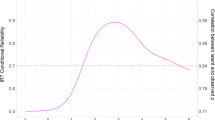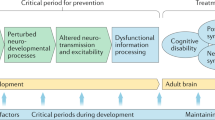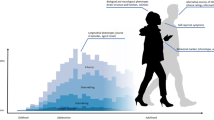Abstract
Schizophrenia has long been thought to be clinically heterogeneous. A range of studies suggests that this is due to genetic heterogeneity. Some clinical features, such as negative symptoms, are associated with a greater risk of illness in relatives. Affected sibling pairs are correlated for clinical and course features as well as subforms of illness, and twin studies suggest that this is due to genetic factors. This is further supported by findings that subjects from families linked to some chromosomal regions may differ clinically from those from unlinked families. Moreover, some genes may affect clinical features without altering susceptibility (ie are modifier genes). High-risk genotypes may have quantitative, rather than categorical effects, and may influence milder or subclinical phenotypes. Another recent finding is that nonpsychotic relatives may have personality features that resemble those of their affected relatives. These findings taken together suggest that there may be several classes of gene action in schizophrenia: some genes may influence susceptibility only, others may influence clinical features only, and still others may have a mixed effect. Furthermore, subsets of these classes may affect personality and other traits in nonpsychotic relatives. Understanding these classes of gene action may help guide the design of linkage and association studies that have increased power. We describe five classes of genes and their predictions of the outcomes of family, twin, and several types of linkage studies. We go on to explore how these predictions can in turn be used to aid in the design of linkage studies.
This is a preview of subscription content, access via your institution
Access options
Subscribe to this journal
Receive 12 print issues and online access
$259.00 per year
only $21.58 per issue
Buy this article
- Purchase on Springer Link
- Instant access to full article PDF
Prices may be subject to local taxes which are calculated during checkout
Similar content being viewed by others
References
Harrison PJ, Owen MJ . Genes for schizophrenia? Recent findings and their pathophysiological implications. Lancet 2003; 361: 417–419.
Kraepelin E . Manic-Depressive Illiness and Paranoia. Edinburgh, E & S Livingstone: Scotland, 1921.
McGlashan TH, Fenton WS . Classical subtypes for schizophrenia: literature review for DSM-IV. Schizophr Bull 1991; 17: 609–632.
Peralta V, Cuesta MJ . How many and which are the psychopathological dimensions in schizophrenia? Issues influencing their ascertainment. Schizophr Res 2001; 49: 269–285.
Malaspina D, Goetz RR, Yale S, Berman A, Friedman JH, Tremeau F et al. Relation of familial schizophrenia to negative symptoms but not to the deficit syndrome. Am J Psychiatry 2000; 157: 994–1003.
Cardno AG, Thomas K, McGuffin P . Clinical variables and genetic loading for schizophrenia: analysis of published Danish adoption study data. Schizophr Bull 2002; 28: 393–399.
Kirkpatrick B, Ross DE, Walsh D, Karkowski L, Kendler KS . Family characteristics of deficit and nondeficit schizophrenia in the Roscommon Family Study. Schizophr Res 2000; 45: 57–64.
Kirkpatrick B, Buchanan RW, Ross DE, Carpenter Jr WT . A separate disease within the syndrome of schizophrenia. Arch Gen Psychiatry 2001; 58: 165–171.
Kendler KS, McGuire M, Gruenberg AM, Walsh D . Clinical heterogeneity in schizophrenia and the pattern of psychopathology in relatives: results from an epidemiologically based family study. Acta Psychiatr Scand 1994; 89: 294–300.
Kendler KS, Karkowski-Shuman L, O’Neill FA, Straub RE, MacLean CJ, Walsh D . Resemblance of psychotic symptoms and syndromes in affected sibling pairs from the Irish Study of high-density schizophrenia families: evidence for possible etiologic heterogeneity. Am J Psychiatry 1997; 154: 191–198.
Loftus J, DeLisi LE, Crow TJ . Factor structure and familiality of first-rank symptoms in sibling pairs with schizophrenia and schizoaffective disorder. Br J Psychiatry 2000; 177: 15–19.
Cardno AG, Jones LA, Murphy KC, Sanders RD, Asherson P, Owen MJ et al. Dimensions of psychosis in affected sibling pairs. Schizophr Bull 1999; 25: 841–850.
Sullivan PF, Kendler KS, Neale MC . Schizophrenia as a complex trait: evidence from a meta-analysis of twin studies. Arch Gen Psychiatry 2003; 60: 1187–1192.
Cardno AG, Sham PC, Farmer AE, Murray RM, McGuffin P . Heritability of Schneider's first-rank symptoms. Br J Psychiatry 2002; 180: 35–38.
Cardno AG, Sham PC, Murray RM, McGuffin P . Twin study of symptom dimensions in psychoses. Br J Psychiatry 2001; 179: 39–45.
Kendler KS, Myers JM, O’Neill FA, Martin R, Murphy B, MacLean CJ et al. Clinical features of schizophrenia and linkage to chromosomes 5q, 6p, 8p, and 10p in the Irish Study of high-density schizophrenia families. Am J Psychiatry 2000; 157: 402–408.
Chiu YF, McGrath JA, Thornquist MH, Wolyniec PS, Nestadt G, Swartz KL et al. Genetic heterogeneity in schizophrenia II: conditional analyses of affected schizophrenia sibling pairs provide evidence for an interaction between markers on chromosome 8p and 14q. Mol Psychiatry 2002; 7: 658–664.
Kaiser R, Konneker M, Henneken M, Dettling M, Muller-Oerlinghausen B, Roots I et al. Dopamine D4 receptor 48-bp repeat polymorphism: no association with response to antipsychotic treatment, but association with catatonic schizophrenia. Mol Psychiatry 2000; 5: 418–424.
Serretti A, Lilli R, Lorenzi C, Lattuada E, Smeraldi E . DRD4 exon 3 variants associated with delusional symptomatology in major psychoses: a study on 2,011 affected subjects. Am J Med Genet 2001; 105: 283–290.
Serretti A, Lattuada E, Lorenzi C, Lilli R, Smeraldi E . Dopamine receptor D2 Ser/Cys 311 variant is associated with delusion and disorganization symptomatology in major psychoses. Mol Psychiatry 2000; 5: 270–274.
Zhang XY, Zhou DF, Zhang PY, Wei J . The CCK-A receptor gene possibly associated with positive symptoms of schizophrenia. Mol Psychiatry 2000; 5: 239–240.
Malhotra AK, Goldman D, Mazzanti C, Clifton A, Breier A, Pickar D . A functional serotonin transporter (5-HTT) polymorphism is associated with psychosis in neuroleptic-free schizophrenics. Mol Psychiatry 1998; 3: 328–332.
Fanous AH, Neale MC, Straub RE, Webb BT, O’Neill AF, Walsh D et al. Clinical features of psychotic disorders and polymorphisms in HT2A, DRD2, DRD4, SLC6A3 (DAT1), and BDNF: a family based association study. Am J Med Genet 2004; 125B: 69–78.
Cardno AG, Bowen T, Guy CA, Jones LA, McCarthy G, Williams NM et al. CAG repeat length in the hKCa3 gene and symptom dimensions in schizophrenia. Biol Psychiatry 1999; 45: 1592–1596.
Riazuddin S, Castelein CM, Ahmed ZM, Lalwani AK, Mastroianni MA, Naz S et al. Dominant modifier DFNM1 suppresses recessive deafness DFNB26. Nat Genet 2000; 26: 431–434.
Salvatore F, Scudiero O, Castaldo G . Genotype–phenotype correlation in cystic fibrosis: the role of modifier genes. Am J Med Genet 2002; 111: 88–95.
DeStefano AL, Lew MF, Golbe LI, Mark MH, Lazzarini AM, Guttman M et al. PARK3 influences age at onset in Parkinson disease: a genome scan in the GenePD study. Am J Hum Genet 2002; 70: 1089–1095.
Cardno AG, Holmans PA, Rees MI, Jones LA, McCarthy GM, Hamshere ML et al. A genomewide linkage study of age at onset in schizophrenia. Am J Med Genet 2001; 105: 439–445.
McGlashan TH, Fenton WS . Subtype progression and pathophysiologic deterioration in early schizophrenia. Schizophr Bull 1993; 19: 71–84.
Arndt S, Andreasen NC, Flaum M, Miller D, Nopoulos P . A longitudinal study of symptom dimensions in schizophrenia. Prediction and patterns of change. Arch Gen Psychiatry 1995; 52: 352–360.
Fanous A, Gardner C, Walsh D, Kendler KS . Relationship between positive and negative symptoms of schizophrenia and schizotypal symptoms in nonpsychotic relatives. Arch Gen Psychiatry 2001; 58: 669–673.
Kendler KS, McGuire M, Gruenberg AM, O’Hare A, Spellman M, Walsh D . The Roscommon Family Study. III. Schizophrenia-related personality disorders in relatives. Arch Gen Psychiatry 1993; 50: 781–788.
MacDonald III AW, Pogue-Geile MF, Johnson MK, Carter CS . A specific deficit in context processing in the unaffected siblings of patients with schizophrenia. Arch Gen Psychiatry 2003; 60: 57–65.
Park S, Holzman PS, Goldman-Rakic PS . Spatial working memory deficits in the relatives of schizophrenic patients. Arch Gen Psychiatry 1995; 52: 821–828.
Turetsky BI, Cannon TD, Gur RE . P300 subcomponent abnormalities in schizophrenia: III. Deficits In unaffected siblings of schizophrenic probands. Biol Psychiatry 2000; 47: 380–390.
Michie PT, Innes-Brown H, Todd J, Jablensky AV . Duration mismatch negativity in biological relatives of patients with schizophrenia spectrum disorders. Biol Psychiatry 2002; 52: 749–758.
Cannon TD, van Erp TG, Huttunen M, Lonnqvist J, Salonen O, Valanne L et al. Regional gray matter, white matter, and cerebrospinal fluid distributions in schizophrenic patients, their siblings, and controls. Arch Gen Psychiatry 1998; 55: 1084–1091.
Staal WG, Hulshoff Pol HE, Schnack HG, Hoogendoorn ML, Jellema K, Kahn RS . Structural brain abnormalities in patients with schizophrenia and their healthy siblings. Am J Psychiatry 2002; 159: 244–250.
Siever LJ, Davis KL . The pathophysiology of schizophrenia disorders: perspectives from the spectrum. Am J Psychiatry 2004; 161: 398–413.
Avramopoulos D, Stefanis NC, Hantoumi I, Smyrnis N, Evdokimidis I, Stefanis CN . Higher scores of self reported schizotypy in healthy young males carrying the COMT high activity allele. Mol Psychiatry 2002; 7: 706–711.
Goldberg TE, Egan MF, Gscheidle T, Coppola R, Weickert T, Kolachana BS et al. Executive subprocesses in working memory: relationship to catechol-O-methyltransferase Val158Met genotype and schizophrenia. Arch Gen Psychiatry 2003; 60: 889–896.
Egan MF, Goldberg TE, Kolachana BS, Callicott JH, Mazzanti CM, Straub RE et al. Effect of COMT Val108/158 Met genotype on frontal lobe function and risk for schizophrenia. Proc Natl Acad Sci USA 2001; 98: 6917–6922.
Malhotra AK, Kestler LJ, Mazzanti C, Bates JA, Goldberg T, Goldman D . A functional polymorphism in the COMT gene and performance on a test of prefrontal cognition. Am J Psychiatry 2002; 159: 652–654.
Coppen A . Effects of a depressive illness on MPI scores. Br J Psychiatry 111; 236–239: 1965.
Kendler KS, Neale MC, Kessler RC, Heath AC, Eaves LJ . A longitudinal twin study of personality and major depression in women. Arch Gen Psychiatry 1993; 50: 853–862.
Weickert CS, Straub RE, McClintock BW, Matsumoto M, Hashimoto R, Hyde TM et al. Human dysbindin (DTNBP1) gene expression in normal brain and in schizophrenic prefrontal cortex and midbrain. Arch Gen Psychiatry 2004; 61: 544–555.
Hashimoto R, Straub RE, Weickert CS, Hyde TM, Kleinman JE, Weinberger DR . Expression analysis of neuregulin-1 in the dorsolateral prefrontal cortex in schizophrenia. Mol Psychiatry 2004; 9: 299–307.
Talbot K, Eidem WL, Tinsley CL, Benson MA, Thompson EW, Smith RJ et al. Dysbindin-1 is reduced in intrinsic, glutamatergic terminals of the hippocampal formation in schizophrenia. J Clin Invest 2004; 113: 1353–1363.
Neale MC, Eaves LJ, Kendler KS . The power of the classical twin study to resolve variation in threshold traits. Behav Genet 1994; 24: 239–258.
Kotchen TA, Broeckel U, Grim CE, Hamet P, Jacob H, Kaldunski ML et al. Identification of hypertension-related QTLs in African American sib pairs. Hypertension 2002; 40: 634–639.
Martin LJ, Comuzzie AG, Dupont S, Vionnet N, Dina C, Gallina S et al. A quantitative trait locus influencing type 2 diabetes susceptibility maps to a region on 5q in an extended French family. Diabetes 2002; 51: 3568–3572.
Brzustowicz LM, Honer WG, Chow EW, Hogan J, Hodgkinson K, Bassett AS . Use of a quantitative trait to map a locus associated with severity of positive symptoms in familial schizophrenia to chromosome 6p. Am J Hum Genet 1997; 61: 1388–1396.
Wilcox MA, Faraone SV, Su J, Van Eerdewegh P, Tsuang MT . Genome scan of three quantitative traits in schizophrenia pedigrees. Biol Psychiatry 2002; 52: 847–854.
Weinberger DR . Implications of normal brain development for the pathogenesis of schizophrenia. Arch Gen Psychiatry 1987; 44: 660–669.
Woods BT . Is schizophrenia a progressive neurodevelopmental disorder? Toward a unitary pathogenetic mechanism. Am J Psychiatry 1998; 155: 1661–1670.
Chakos M, Lieberman J, Hoffman E, Bradford D, Sheitman B . Effectiveness of second-generation antipsychotics in patients with treatment-resistant schizophrenia: a review and meta-analysis of randomized trials. Am J Psychiatry 2001; 158: 518–526.
Levinson DF, Levinson MD, Segurado R, Lewis CM . Genome scan meta-analysis of schizophrenia and bipolar disorder, part I: Methods and power analysis. Am J Hum Genet 2003; 73: 17–33.
Segurado R, Detera-Wadleigh SD, Levinson DF, Lewis CM, Gill M, Nurnberger Jr JI et al. Genome scan meta-analysis of schizophrenia and bipolar disorder, part III: Bipolar disorder. Am J Hum Genet 2003; 73: 49–62.
Lewis CM, Levinson DF, Wise LH, DeLisi LE, Straub RE, Hovatta I et al. Genome scan meta-analysis of schizophrenia and bipolar disorder, part II: Schizophrenia. Am J Hum Genet 2003; 73: 34–48.
Fanous A, Gardner CO, Prescott CA, Cancro R, Kendler KS . Neuroticism, major depression and gender: a population-based twin study. Psychol Med 2002; 32: 719–728.
McGuffin P, Rijsdijk F, Andrew M, Sham P, Katz R, Cardno A . The heritability of bipolar affective disorder and the genetic relationship to unipolar depression. Arch Gen Psychiatry 2003; 60: 497–502.
Kendler KS, Neale MC, Kessler RC, Heath AC, Eaves LJ . Major depression and generalized anxiety disorder. Same genes, (partly) different environments? Arch Gen Psychiatry 1992; 49: 716–722.
Prescott CA, Aggen SH, Kendler KS . Sex-specific genetic influences on the comorbidity of alcoholism and major depression in a population-based sample of US twins. Arch Gen Psychiatry 2000; 57: 803–811.
Fu Q, Heath AC, Bucholz KK, Nelson E, Goldberg J, Lyons MJ et al. Shared genetic risk of major depression, alcohol dependence, and marijuana dependence: contribution of antisocial personality disorder in men. Arch Gen Psychiatry 2002; 59: 1125–1132.
Neale MCCL . Methodology for Genetic Studies of Twins and Families. Dordrecht, Kluwer Academic: The Netherlands, 1992.
Acknowledgements
This work was supported by NIH Grants MH-41953, MH-52537, MH-45390, and IT-32 MH-20030. AF was supported by an APA/Lilly Psychiatric Research Fellowship and a Young Investigator Award from the American Foundation for Suicide Prevention. We acknowledge the contributions of Michael C Neale, Ph.D., Brien Riley, Ph.D., Xiangning Chen, Ph.D., Todd Webb, Ph.D., Edwin van den Oord, Ph.D., Joseph McClay, Ph.D., Anthony F O’Neill, M.D., Dermot Walsh, MB, FRCPI, and Richard Straub, Ph.D. to unpublished work cited in this paper.
Author information
Authors and Affiliations
Corresponding author
Rights and permissions
About this article
Cite this article
Fanous, A., Kendler, K. Genetic heterogeneity, modifier genes, and quantitative phenotypes in psychiatric illness: searching for a framework. Mol Psychiatry 10, 6–13 (2005). https://doi.org/10.1038/sj.mp.4001571
Received:
Revised:
Accepted:
Published:
Issue Date:
DOI: https://doi.org/10.1038/sj.mp.4001571
Keywords
This article is cited by
-
Biological subtyping of psychiatric syndromes as a pathway for advances in drug discovery and personalized medicine
Nature Mental Health (2023)
-
Clinical characteristics indexing genetic differences in schizophrenia: a systematic review
Molecular Psychiatry (2023)
-
Clinical characteristics indexing genetic differences in bipolar disorder – a systematic review
Molecular Psychiatry (2023)
-
A novel heterozygous missense variant of the ARID4A gene identified in Han Chinese families with schizophrenia-diagnosed siblings that interferes with DNA-binding activity
Molecular Psychiatry (2022)
-
Shared genetic architecture between schizophrenia and subcortical brain volumes implicates early neurodevelopmental processes and brain development in childhood
Molecular Psychiatry (2022)



